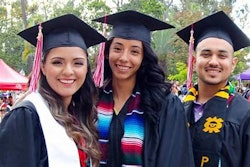After two decades of prayers, politicking and impassioned pleas, tribal colleges have gained greater access to federal grants under an executive order signed by President Clinton.
“Hot damn,” said an elated Dr. Janine Pretty On Top, president of Little Big Horn College on the Crow reservation in Montana. “It’s a big coup for such a small group of colleges.”
Pretty On Top and other officials with the nation’s twenty-nine tribal-run colleges have been pressing every administration for such an order since President Carter was in office. The order, similar to ones for historically Black colleges and universities and Hispanic-serving institutions, requires federal agencies to consider the colleges for contracts and grants.
Called the White House Initiative on Tribal Colleges and Universities, it also creates an advisory panel that will annually grade the agencies’ progress. The panel also will push for the colleges’ accreditation, promote preservation of native languages and cultures, and strengthen the schools’ links to other education programs.
The tribal colleges, which stretch from California to Wisconsin, have been overlooked in the past because of their small size and remote locations, Native-American officials said.
“There has been a tendency to believe all Indians are taken care of through the Bureau of Indian Affairs,” said Dr. Gerald Monette, president of the American Indian Higher Education Consortium. The colleges, chartered by tribes to serve 25,000 students in twelve states, rely on the federal government for 50 percent to 90 percent of their funding. But that has not been enough. Research indicates tribal colleges received an average of $2,900 for each full-time student last year. That compares to $6,200 per student for most other community colleges.
“It’s been difficult times for tribal colleges because of the cutbacks in federal spending,” Monette said. “They have been treated like other parts of the government and had to scale back.” Although the tribal colleges have been authorized to receive up to $40 million, Monette said that the colleges “have never seen close to that amount.” For the past two years, the schools have received about $20 million. And unlike their counterparts, mainstream community colleges, the tribal colleges in most cases receive no money from the states in which they are located.
“In most instances, states have not felt they had an obligation to fund higher education institutions on Indian reservations,” Monette said. “They see that as a federal responsibility.” Even though tribal colleges began pressing for the executive order in 1970, historically slack institutions received a similar order in 1980 and one was signed for Hispanic-serving institutions in 1990.
“Those orders have been extremely successful in gaining dollars for those institutions,” said Veronica Gonzales, the consortium’s director of federal relations. “Even though we were advocating for this before the HBCUs, I think our colleges were smaller and more remote. It was just a matter of getting the attention of the right people.”
U.S. Education Secretary Richard W. Riley said that the tribal colleges “provide an invaluable service and it’s time that we look for ways to increase their contribution.” Ada Deer, assistant secretary of the federal Bureau of Indian Affairs, said the executive order “will enhance tribal sovereignty and create tools for Indian people to be more self-sufficient. About two-thirds of the students at these colleges are women,” she said. “Many have gone on to become teachers.”
Deer, acknowledging that twenty years is a long time to wait, said that “government many times moves slowly.” She credited Interior Secretary Bruce Babbitt for strongly supporting the measure. Dr. Verna Fowler is president of the College of the Menominee Nation in Kasheena, Wisconsin. Established in 1993, it is the newest of the twenty-nine colleges and serves 255 students.
Fowler said she believes it took twenty years to get the executive order signed because “there are people in Washington who don’t even know that [tribal colleges] exist.” Despite the excitement that Fowler and other tribal college officials said they feel now that the order has been signed, they also realize the order doesn’t translate into instant money. It will take up to two years for the various agencies to begin considering which funds would be eligible for the tribal colleges and how the colleges might aid in some of the agencies’ programs.
“There are no guarantees,” warned Pretty On Top. “It doesn’t mean there is a bunch of money out there just waiting for us. It means an opportunity.” Tribal college officials believe the order will enable them to form partnerships with some federal agencies — such as the Agriculture, Commerce and Transportation departments — to conduct research areas in which the colleges have expertise. “We have expertise in rural development because all of our colleges are rurally located and we work with small, economically hard-pressed communities,” Pretty On Top explained.
Some tribal colleges have initiated talks with the Defense Department, seeking grants to research on how best to provide social services to minorities and rural peoples. “These are the sorts of the things that the tribal colleges couldn’t apply for before the executive order because we were not eligible,” Pretty On Top said. “And this is just a hint of what could happen.
“This doesn’t necessarily mean a whole lot of new money,” she added. “It means opportunity, a chance to open the frontiers of opportunity for faculty and students.”
RELATED ARTICLE:
The 29 U.S. American Indian Colleges
1 Bay Mills Community College, Brimley, Mich.
2 Blackfeet Community College, Browning, Mont.
3 Cheyenne River Community College, Eagle Butte, S.D.
4 College of the Menominee Nation, Keshena, Wis.
5 Crownpoint of Technology, Crownpoint, N.M.
6 D-Q University, Davis, Calif.
7 Dull Knife Memorial College, Lame Deer, Mont.
8 Fond du Lac Community College, Cloquet, Minn.
9 Fort Belknap Community College, Harlem, Mont.
10 Fort Berthold Community College, New Town, N.D.
11 Fort Peck Community College, Poplar, Mont.
12 Haskell Indian Nations University, Lawrence, Kan.
13 Institute of American Indian Arts, Sante Fe, N.M
14 Lac Courte Oreilles Ojibwa Community College, Hayward, Wis.
15 Leech Lake Tribal College, Cass Lake, Minn.
16 Little big Horn College, Crow Agency, Mont.
17 Little Hoop Community College, Fort Trotten, N.D.
18 Navajo Community College, Tsaile, Ariz.
19 Nebraska Indian Community College, Winnebago, Neb.
20 Northwest Indian College, Bellingham, Wash.
21 Oglala Lakota College, Kyle, S.D.
22 Salish Kootenai College, Pablo, Mont.
23 Sinte Gleska University, Rosebud, S.D.
24 Sitting Bull College, Fort Yates, N.D.
25 Sisseton-Wahpeton Community College, Sisseton, S.D.
26 Southwestern Indian Polytechnic Institute, Albuquerque, N.M.
27 Stone Child Community College, Box Elder, Mont.
28 Turtle Mountain Community College, Belcourt, N.D.
29 United Tribes Technical College, Bismarck, N.D.
COPYRIGHT 1996 Cox, Matthews & Associates
© Copyright 2005 by DiverseEducation.com


















